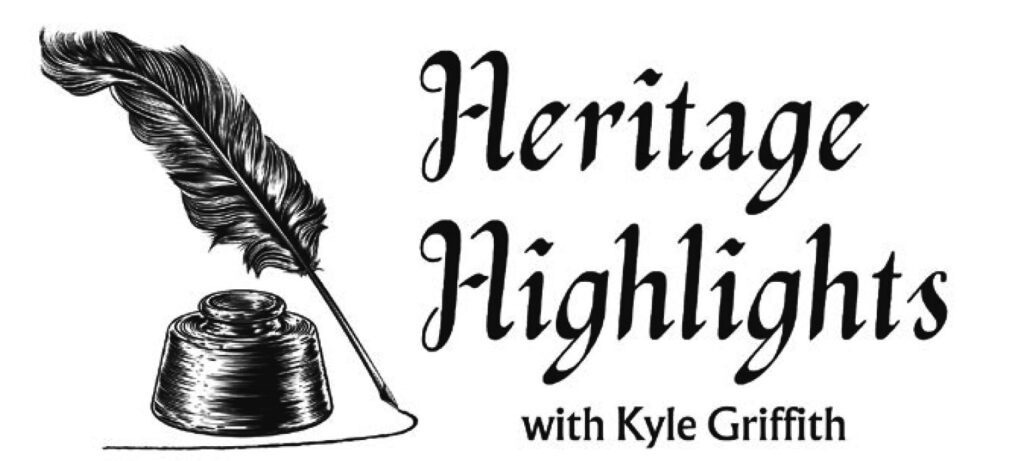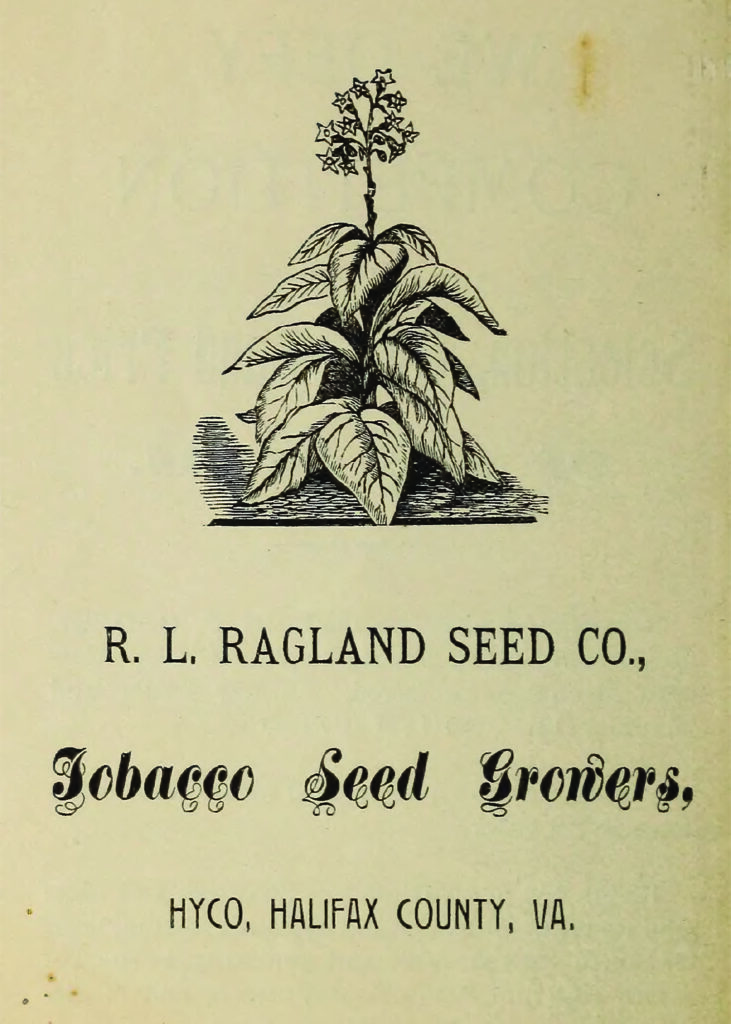
**This research was first published in the October 9, 2024 edition of the Chatham Star-Tribune newspaper as part of Kyle Griffith’s weekly segment entitled “Heritage Highlights.”
The back cover of Ragland’s 1895 seed catalog featuring an illustration of a tobacco plant
Throughout the nineteenth century, countless new varieties of tobacco were selectively crossed and advertised according to their desirable features–whether that be broader leaves, a brighter yellow color, or the intended use of the cured leaf. The R. L. Ragland Seed Company operated out of Halifax County, Virginia on their Hyco Tobacco Seed Farm. For the 1894-1895 season, they published a “Wholesale Catalogue of Reliable Tobacco Seeds.” The small pamphlet boasts that it offers “the newest and best varieties…for every type of tobacco, improved by continuous selection…and of the highest vitality. Tobacco seeds are categorized in lists from bright to dark. The most desirable forms of Virginia bright leaf are categorized first, followed by standard manufacturing leaf, then dark export leaf.
The select list of bright and mahogany leaf offered seeds for $1.50 per pound, which would be enough for hundreds of thousands of plants. That price has an equivalent purchasing power to about $55 today. First on the list, unsurprisingly, Robert Ragland praises his own “Ragland’s Conqueror” which claims to be “his ideal of a superb bright yellow…easily cured to the brightest color.” Unlike the rest, he mentions no details about the cross of varieties he used to create the seed. “Bonanza,” however, is immediately labeled as a cross of white burley and yellow Orinoco, “tougher than the Burley and more porous than the Orinoco, and therefore makes superior wrappers, cutters, and fillers.” The “Safrano” variety was a cross of Hyco and White Burley, taking its name from the rich yellow color like that of a saffron rose. Mr. Ragland assured it was one of the most beautiful he had ever planted, and it possessed a “soft silky texture, and delightful flavor.” The “Gold Finder” variety consisted of yellow crossed with white burley, and is advertised to “succeed admirably both East and West.” The “Bullion” variety describes a “stately, broad-leafed” variety crossed with white burley and hester, which has leaves that grow further apart vertically than other types. Next, “Oak Hill Yellow” is said to cure a whitish-yellow color and contain delicate fibers. “It has already won its way to favor, and is destined to become a favorite,” he wrote. A few other new “Ragland’s Improved” varieties and undescriptive seeds are listed as well, like “Tuckahoe” and “Gooch.” Last on the list, “One Sucker” saves the farmer some work by only bearing one growth of flowers (suckers).
For the standard list of manufacturing leaf, a wide variety of seeds developed in Southern Virginia and North Carolina were available. All were priced at $1.00 per pound (about $37 today). A seed called “Flanagan,” which was a variety of Old Sweet Orinoco, originated in Henry County, Virginia and was “greatly used for making sweet fillers and mahogany wrappers.” “Little Oronoka” tobacco features a quote from B. F. Gravely & Sons of Leatherwood, Virginia, who said it grew “fully 10 days earlier than any grown here. It will also stand on the hill after ripening a considerable time without injury by becoming over-ripe.” From the James River region, “Blue Pryor” became a popular variety for shipping out, allegedly “superior to Blue Pryor grown in Kentucky. The “Granville County Yellow” variety states that planters “average from 20 to 50 dollars per hundred pounds.” The “Hester” variety also originated in Granville, N.C. and was notable as “fine cigar stock.” It was said to have greater adaptability to a range of soils as compared to other yellow varieties.
Options from the list of “Dark, Rich Export Leaf” were available for $1.25 per pound (about $46 today). These varieties would have been less prevalent in Virginia than the ones covered already, but are still useful in differentiating from the preferred bright leaf used in the Old Belt. “Kentucky Yellow” was among the newest and largest plants available, and the “Tennessee Red” variety proved to be excellent for dark strips. “Clardy” had desirable “large, waxy, and tough” leaves. Finally, “Lacks” was preferable for gray or dark soils and was also known as “Beat All” or “Jesup.” in some areas. Overall, Ragland’s selection of seeds provides a decent idea of the sort of attributes farmers looked for in their crop 130 years ago.

